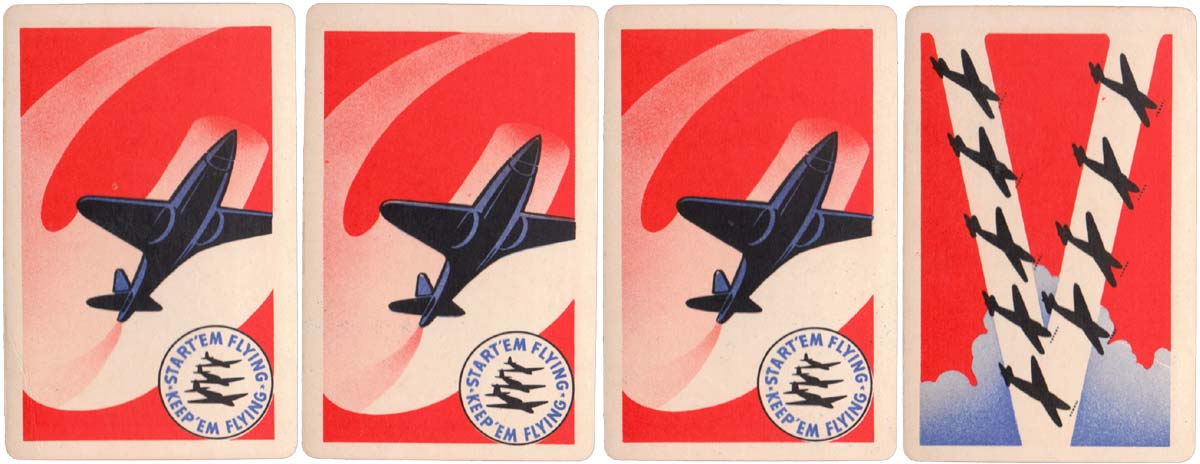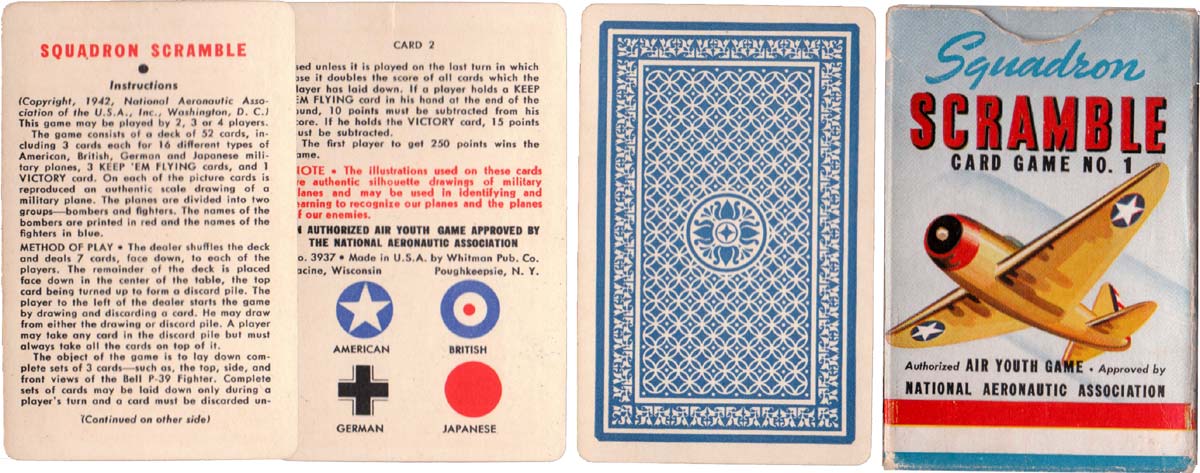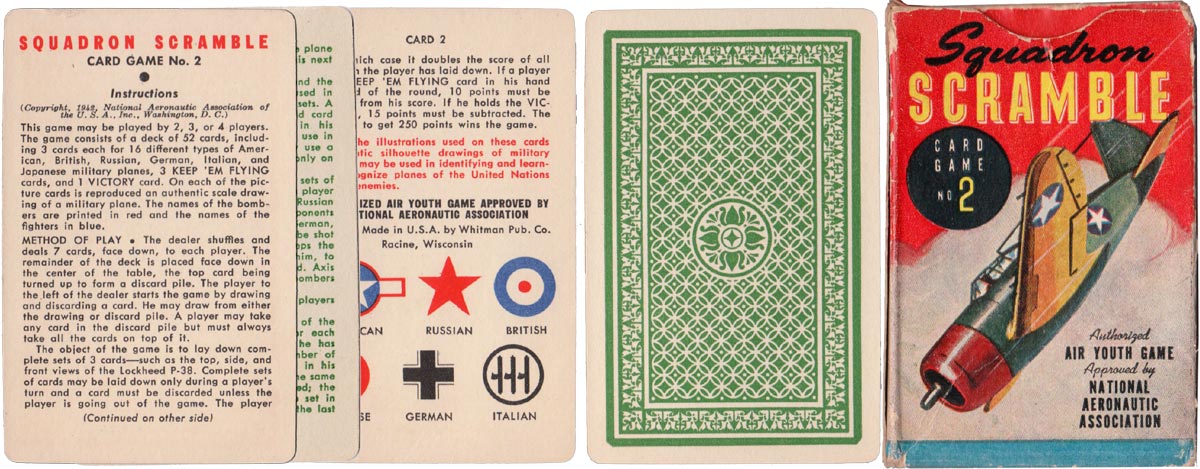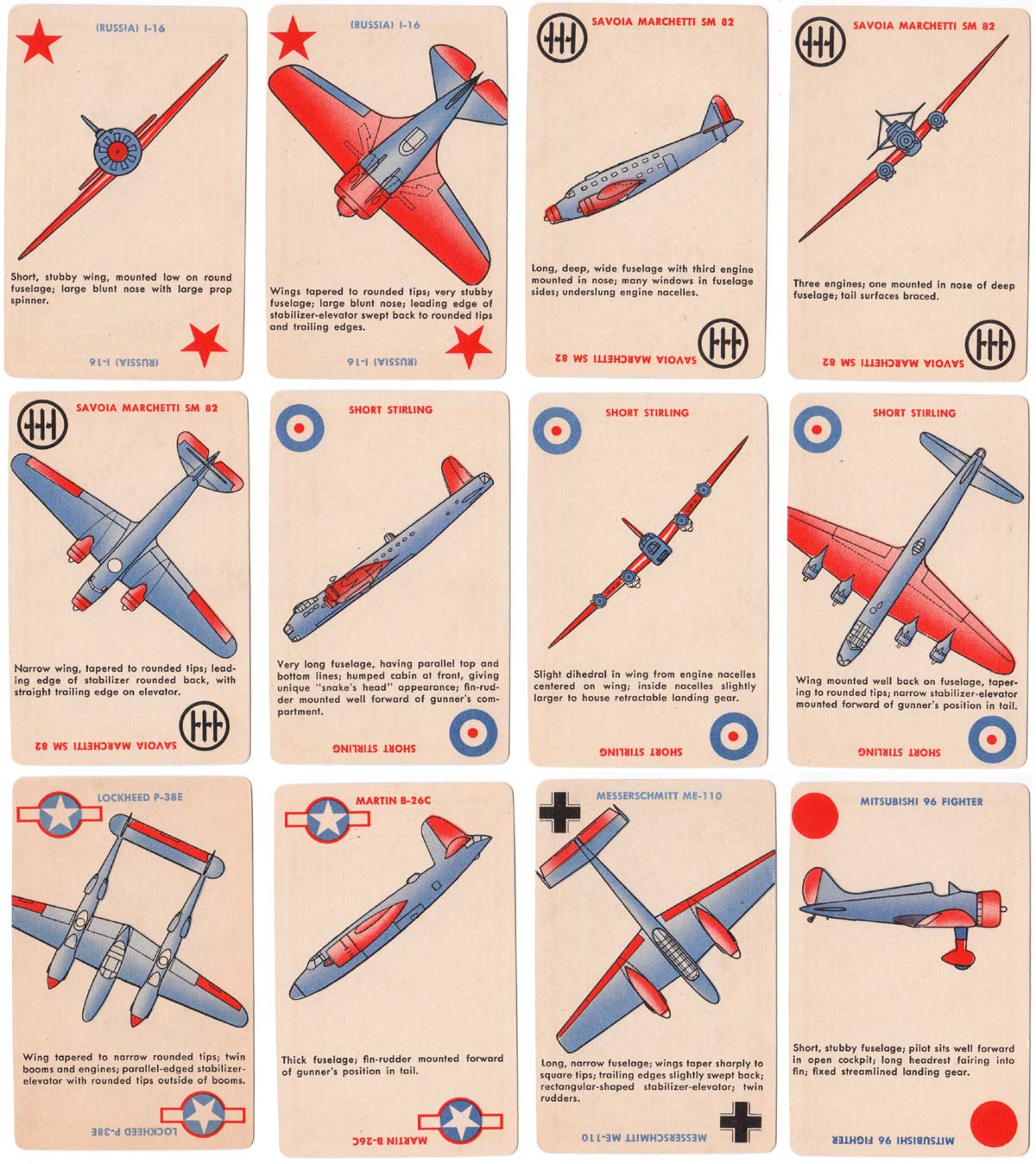Squadron Scramble
“Squadron Scramble” card games for identifying military planes, Whitman Publishing Co., Racine, Wisconsin, 1942.
‘Squadron Scramble’ card game no.1 was designed for learning to identify American, British, German and Japanese WW2 military planes, manufactured by Whitman Publishing Co., Racine, Wisconsin, 1942. Each card has an authentic scale drawing of a military airplane plus recognition tips. The names of bomber aircraft are printed in red, fighters in blue. See the Instruction card►
Above: “Squadron Scramble” card game no.1 for identifying military planes, © copyright National Aeronautic Association of the USA, printed by Whitman Publishing Co., Racine, Wisconsin, 1942. 52 cards, including 3 “Keep ’em Flying” cards and one “Victory” card, plus instructions card in box. Images courtesy Rex Pitts.


-
Squadron Scramble No.2
‘Squadron Scramble’ card game no.2 was of similar design for learning to identify American, British, German, Russian, Italian and Japanese WW2 military planes, manufactured by Whitman Publishing Co., Racine, Wisconsin, 1942. See the Instruction card►


Above: ‘Squadron Scramble’ card game no.2, of similar design to game no.1, but with green backs.
FURTHER REFERENCE

By Rex Pitts (1940-2021)
Member since January 30, 2009
Rex's main interest was in card games, because, he said, they were cheap and easy to get hold of in his early days of collecting. He is well known for his extensive knowledge of Pepys games and his book is on the bookshelves of many.
His other interest was non-standard playing cards. He also had collections of sheet music, music CDs, models of London buses, London Transport timetables and maps and other objects that intrigued him.
Rex had a chequered career at school. He was expelled twice, on one occasion for smoking! Despite this he trained as a radio engineer and worked for the BBC in the World Service.
Later he moved into sales and worked for a firm that made all kinds of packaging, a job he enjoyed until his retirement. He became an expert on boxes and would always investigate those that held his cards. He could always recognize a box made for Pepys, which were the same as those of Alf Cooke’s Universal Playing Card Company, who printed the card games. This interest changed into an ability to make and mend boxes, which he did with great dexterity. He loved this kind of handicraft work.
His dexterity of hand and eye soon led to his making card games of his own design. He spent hours and hours carefully cutting them out and colouring them by hand.
Related Articles

Sea-Dog playing cards
Ships’ prows, figureheads and signal flags promoting Sea-Dog Line marine hardware.

Scientific Whist
“Scientific Whist” : standard cards with instructions for play on the faces by Chas Goodall & Son, 1...

Historic Shakespeare
“Historic Shakespeare” playing cards featuring Shakespearean characters by Chas Goodall & Son.

Heartsette by Herbert Fitch & Co, 1893
A glimpse into a busy print and design office in late Victorian London.

Rap Rummy
Rap Rummy made by Parker Brothers in 1926, only 4 years after the discovery of King Tutankhamen’s to...

German Travel Cards
A travel-themed educational deck helping American tourists visiting Germany.

Can You Believe Your Eyes?
“Can You Believe Your Eyes?” playing cards featuring visual illusions & other oddities.

The European Interchanges Quartets
A card game based around motorway intersections from European countries.

Love Tests
Vintage novelty “Love Test” cards of a slightly saucy nature but all in good fun!

Briefmarken-Quartett
Quartet game featuring postage stamps from the Zones of Occupation in post-WWII Germany.

Get Decked
Black and white cartoons devised by Sam Wagner with help from artist Lindsay Bevington.

Doctor Who Trump Card Game
Game for two players in which Doctor Who and the Legendary Legion join battle with the Alien Hordes....

Baraja de Juan Martín Zamorano
Deck inspired by El Pendón de los Zamorano, a military pennant dating from 1501, published by Priego...

Beowulf
Jackson Robinson's Beowulf playing card deck inspired by the Old English pagan poem.

Keith Haring playing cards
Energetic graffiti images by the American artist Keith Haring.

Polygo™
Cards of irregular, four-sided shape for playing word and colour games as well as more traditional o...
Most Popular
Our top articles from the past 28 days







